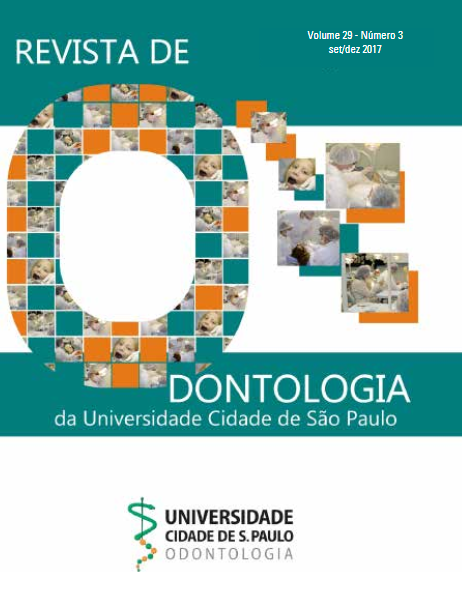O efeito de diferentes níveis de PH em soluções de flúor a 1,1% na corrosão de arcos NITI
DOI:
https://doi.org/10.26843/ro_unicidv2932017p237-242Palavras-chave:
Arco NiTi, Corrosão, Solução FluoretadaResumo
Objetivo: Determinar o pH crítico para ocorrer a corrosão de arcos NiTi em soluções de flúor a 1,1%, variando o pH de 3,5 a 7,0. Materiais e Métodos: Doze amostras com 10mm de comprimento de fio superelástico NiTi 0017 x 0025 (Abzil), obtidas do segmento distal dos arcos. As amostras foram aleatoriamente separadas e imersas dentro de recipientes contendo 40ml de seis soluções (água, soluções fluoretadas com pH: 3,5; 4,0; 4,5; 5,0; 5,5; 6,0; 6,5 e 7,0), sob uma mesa agitadora durante 90 minutos. Todas as amostras foram, então, levadas ao MEV. As imagens das amostras imersas em água e soluções fluoretadas com pH 7,0, 6,5 e 6,0 não se apresentaram diferentes, no entanto a partir da solução fluoretada com pH 5,5, as imagens superficiais apresentaram características diferentes dos grupos anteriores. Conclusão: Com base nos resultados obtidos neste estudo, o pH crítico para corrosão de arcos NiTi em soluções de flúor a 1,1% parece estar entre 6,0 e 5,5.
Downloads
Referências
Schiff N, Boinet M, Morgon L, Lissac M, Dalard F, Grosgogeat B. Galvanic corrosion between orthodontic wires and brackets in fluoride mouthwashes. European journal of orthodontics. 2006;28(3):298-304. Persson M. A 100th anniversary: Sandstedt? s experiments on tissue changes during tooth movement. Journal of orthodontics. 2005;32(1):27-8. Sandhu SS, Shetty VS, Mogra S, Varghese J, Sandhu J, Sandhu JS. Efficiency, behavior, and clinical properties of superelastic NiTi versus multistranded stainless steel wires: a prospective clinical trial. The Angle orthodontist. 2012;82(5):915-21. Kusy RP. A review of contemporary archwires: their properties and characteristics. The Angle orthodontist. 1997;67(3):197-207. Dayananda GN, Subba Rao M. Effect of strain rate on properties of superelastic NiTi thin wires. Mater Sci Eng A Struct Mater. 2008;486(1-2):8. Huang HH. Effects of fluoride concentration and elastic tensile strain on the corrosion resistance of commercially pure titanium. Biomaterials. 2002;23(1):5. Kao CT, Ding SJ, He H, Chou MY, Huang TH. Cytotoxicity of orthodontic wire corroded in fluoride solution in vitro. The Angle orthodontist. 2007;77(2):349-54. Kassab EJ, Gomes JP. Assessment of nickel titanium and beta titanium corrosion resistance behavior in fluoride and chloride environments. The Angle orthodontist. 2013;83(5):864-9. Rerhrhaye W, Bahije L, El Mabrouk K, Zaoui F, Marzouk N. Degradation of the mechanical properties of orthodontic NiTi alloys in the oral environment: an in vitro study. International orthodontics / Collège européen d? orthodontie. 2014;12(3):271-80. Alexander SA, Ripa LW. Effects of self- -applied topical fluoride preparations in orthodontic patients. The Angle orthodontist. 2000;70(6):424-30. Lee TH, Huang TK, Lin SY, Chen LK, Chou MY, Huang HH. Corrosion resistance of different nickel-titanium archwires in acidic fluoride-containing artificial saliva. The Angle orthodontist. 2010;80(3):547-53. Yokoyama K, Kaneko K, Moriyama K, Asaoka K, Sakai J, Nagumo M. Hydrogen embrittlement of Ni? Ti superelastic alloy in fluoride solution. J Biomed Mater Res A. 2003;652(2):6. Walker MP, White RJ, Kula KS. Effect of fluoride prophylactic agents on the mechanical properties of nickel-titanium-based orthodontic wires. American journal of orthodontics and dentofacial orthopedics. 2005;127(6):662-9. Watanabe I, Watanabe E. Surface changes induced by fluoride prophylactic agents on titanium-based orthodontic wires. American journal of orthodontics and dentofacial orthopedics. 2003;123(6):653-6. Nakagawa M, Matsuya S, Shiraishi T, Ohta M. Effect of fluoride concentration and pH on corrosion behavior of titanium for dental use. Journal of dental research. 1999;78(9):1568-72. Lausmaa J, Kasemo B, Hansson S. Accelerated oxide grown on titanium implants during autoclaving caused by fluorine contamination. Biomaterials. 1985;6(1):5. Gorelick L, Geiger AM, Gwinnett AJ. Incidence of white spot formation after bonding and banding. American journal of orthodontics. 1982;81(2):93-8. Rolla G, Saxegaard E. Critical evaluation of the composition and use of topical fluorides, with emphasis on the role of calcium fluoride in caries inhibition. Journal of dental research. 1990;69 Spec No:780-5; discussion 820-3. Koushik SRH, Hegde N, Mahesh CM, Chandrashekar BS, Shetty B, Mahendra S. Effect of fluoride prophylactic agents on the mechanical properties of Nickel-Titanium Wires: An in vitro Study. J Ind Orthod Soc. 2011;45(4):6. Mane PP, Pawar R, Ganiger C, Phaphe S. Effect of fluoride prophylactic agents on the surface topography of NiTi and CuNiTi wires. The journal of contemporary dental practice. 2012;13(3):285-8. Yadav SK, Sehgal V, Mittal S. Effects of Fluoride on NiTi Orthodontic Archwires: An X-ray Diffraction Study. J Ind Orthod Soc. 2013;47(4):5. Ramalingam A, Kailasam V, Padmanabhan S, Chitharanjan A. The effect of topical fluoride agents on the physical and mechanical properties of NiTi and copper NiTi archwires. An in vivo study. Australian orthodontic journal. 2008;24(1):26- 31. Bogdanski D, Koller M, Muller D, Muhr G, Bram M, Buchkremer HP, et al. Easy assessment of the biocompatibility of Ni-Ti alloys by in vitro cell culture experiments on a functionally graded Ni-NiTi-Ti material. Biomaterials. 2002;23(23):4549-55. Jaber LC, Rodrigues JA, Amaral FL, Franca FM, Basting RT, Turssi CP. Degradation of orthodontic wires under simulated cariogenic and erosive conditions. Brazilian oral research. 2014;28(1).

